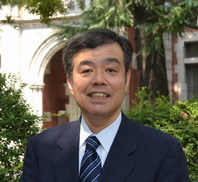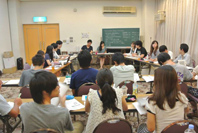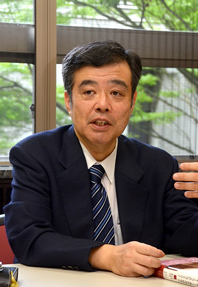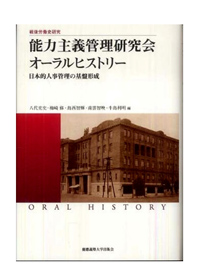Atsushi Yashiro, Professor, Faculty of Business and Commerce
Human Resource Management in Japanese Companies: The Change and Continuity from Empirical Evidence
Atsushi Yashiro

1982 - Graduates from the Faculty of Economics, Keio University
1984 - Completes the master's program at the Graduate School of Business and Commerce, Keio University
1987 - Completes Ph.D. at the Graduate School of Business and Commerce, Keio University.
1996 - Joins the Faculty of Business and Commerce, Keio University, as Associate Professor after working for The Japan Institute.
2003 - Professor at the Faculty of Business and Commerce.
Professor Yashiro visited the London School of Economics (1993-94), Said Business School ,the University of Oxford (2003-04), and The Judge Institute of Management Studies (presently Judge Business School), Cambridge University (2004-05). Ph.D. (Business and Commerce) His publications are “Careers of white-collar employees of large firms: Empirical analysis of transfer and promotion,” “Human resources management for managerial employees: The approach of Labor market theory”, “Human resources management: Its theory and system,” and “Live Lecture: An Introduction to Human Resource Management” (co-authored with Chiaki Nagumo).
Lifetime employment in Japan has “died” time and time again

──Japanese human resource management has changed significantly, especially since the 1980s, with internationalization and the introduction of performance-based management.
I started my career of academics in the late 1980s. If we take a look at HRM since 1980s, it seems that changes have been happening, like the inflow of foreign workers, job destruction from foreign direct investments, translation from Nenko-based pay to a performance-oriented one. Also, the rise of non-regular employment ageing of the workforce is very important. Each time the public eyes pay attention to the change of employment, It has been predicted always that ‘Life-time Employment supposedly meets its demise’. Although Life-time Employment died again and again on the headline of media, however, the essence of Japanese-style management has yet to change.
──What is “the essence of Japanese-style management”?
In an academic terminology, “Lifetime Employment,” is defined as companies recruiting new college graduates as a main source of regular staff. In that sense, “Long-term Employment” may be more appropriate, as they never hire their staff for the entire of their life.
In Japan, the term shushoku katsudo, often translated as “job hunting,” in English, means recruiting new school graduates is synchronized on April. The character for shoku in shushoku stands for “occupation.” But strictly speaking, students do not choose an occupation; rather, they actually choose companies they join as members of the corporate community. So, they start their careers as freshmen from the bottom of the hierarchy. In ten years' time, however, some employees are gradually promoted to the managerial ranks after experiencing cross-functional job-rotation while others developing their expertise in the particular functions, and some staying on the plateau.
Long-term employment makes it difficult for companies to dismiss their employees. Under the Labor Standards Act, an employer is able to discharge their employees if the companies give at least 30 days advance notice. However, providing the existence of legal precedents (Hanrei), discharging workers as a mean of employment adjustment is actually difficult. In addition to legal disputes, companies may also have to take it into account the social sanctions or substantial damage to its credibility or reputation. In the case of dismissal for restructuring, companies can only dismiss employees after meeting four criteria, such as whether the company has “endeavored to avoid dismissal.” Therefore, unless recruiting new school graduates, mandatory retirement age and legal constraints change, the essence of Japanese HRM will not change.
Early Selection of Elite in America, Endless Hope of Promotion in Japan

──Based on your comparative research with Western companies, what do you think of the characteristics of HRM in Japan? Please tell us about HRM, particularly for white-collar employees.
Given the new school graduate recruitment and long-term employment, as mentioned previously, selection of promotion is tenure-based. Competition of promotion is within the tenure cohorts, called nenji, the staffs entering a company together as new school graduates in the same year.
In that sense, selection is much like a tournament process, from the pyramidal squeeze of organization. In general, promotion is like from subsection chief (kakaricho) to section chief (kacho), and from kacho to department chief (bucho). Before promoting to kacho, they must be promoted to kakaricho, and kacho before bucho. Therefore, their promotion depends on whether they win or lose in the tournament. Only the winners of the tournament can join the further stages of the competition, which actually makes the process of promotion efficient. Moreover, companies can maintain motivation of staffs as long as they keep the future prospects of upward mobility.
The first stage of the tournament is intentionally set rather long in the case of Japan. According to the survey of the Japan institute of Labour, the first selection is 3.4 years after joining the company in the United States, 3.7 years in Germany, and 7.8 years in Japan. Similarly, the majority of nenji lose their prospect of promotion 9.1 years after new school graduates in the United States, 11.5 years in Germany, and 22.3 years, 45 years old in Japan.

──The elite and non-elite differentiation in western companies
To maintain the motivation of the elites, a fast promotion is essential.
However, within a system of new graduate recruitment for long-term employment with an inability to dismiss staff, it is actually a nightmare for companies where the tournament finishes in the early stages, leaving scores of low motivated ones. Consequently, in Japanese companies the promotion gap on the same nenji gradually widens in the long run, but in some cases, staff who “run ahead” of their nenji may stay at what could be called a “resting place” (odoriba), awaiting their fellow nenji to catch up. This Japanese characteristic is thought to be extremely logical under the above-mentioned characteristics of Employment in Japan. But, one of my future topics for research will be how this system is changing due by the external change of environment.
──Have you started the survey of these changes?
Globalization is one of the key elements of accelerating the change of HRM in Japan. In 2012, I contributed “Convergence and divergence in human resources management of investment banks: westernization of Japanese investment banks in Tokyo?” to Keio Business Review, and considered how the competition of acquiring the talented manpower between Japanese companies and foreign-owned ones would influence the change of HRM by comparing investment banks between different capital nationalities in Tokyo.
Oral histories of an epoch in HRM after World War II
I graduated from the Faculty of Economics, but as a student, my feeling for economics was an abstract discipline by mathematical concept like the demand and supply curve. I have been interested in the familiar and tangible, like human resources management and industrial relations. So, I chose the Graduate School of Business and Commerce for my master's program and wrote my thesis on employment management of women. The United Nations adopted the Convention on the Elimination of all Forms of Discrimination against Women (CEDAW). Japan enacted the Equal Employment Opportunity Law to revise domestic law in order to meet its stipulations and there was hot debate on women's employment. I did hope to pursue the field of research which could contribute to society, in doing so, I was greatly influenced by Professor Yoko Sano, my supervisor at the graduate school.
──What kind of research do you plan to carry out in the future?
I am currently engaged in collecting oral histories. These oral histories will remain as a record of how relevant players have behaved as the Japanese HRM changed.
“Oral History: A Study Meeting of Merit-based HRM System” is my first publication of oral history, a collection of interviews which outline the details and debates of six members of the study meeting who compiled “Merit-based Human Resource Management--Theory and Practice,” a report of the Japan Federation of Employers' Associations published in 1969. It has had a significant impact on the Japanese human resource management system. It was revealed that there was constructive discussion in response to increased burden of wages by the continual labor shortage and the subsequent discrepancy between the nenko wage system and the merit system.
──This is an interesting study that explores the background of current HRM and look up the points which were deliberated but left unwritten in the report. It is crucially important to gather the memories of all members.
This was followed by the “Japan Federation of Employers' Association and Post-war Human Resource Management,” which was an oral history of the 1990s' report from the JFEA entitled “The Challenge of Japanese-style Management in a New Era: Directions and Means to Take.” Even now, the report is quoted when contingent workers issue is mentioned; it advocated employment portfolios, hiring not only permanent employees, but also contract workers and temporary ones. It is sometimes quoted to have prefaced the proliferation of temporary workers and, by extension, to have caused the growing economic disparity, leaving some members committed to the report feeling ashamed and even guilty.
These oral histories are low-data rather than the output of research. I am working towards gaining a bird's-eye view of human resource management history in Japan by further crosschecking media and other materials of the day.
*This article appeared in "Kenkyu Saizensen" (Oct. 8, 2013) of Keio University Japanese Website.
*Position titles, etc., are those at the time of the interview.
